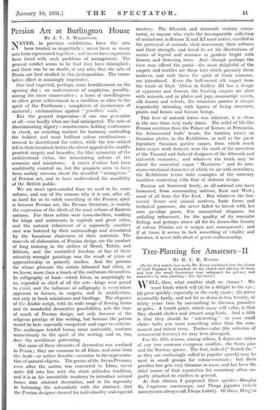Tree-Planting for Amateurs—II
By R. C. K. Exson.
[In his first article last week, Mr. Ensor explained how the charm of rural England is dependent on tho choice and placing of trees, and how the small landowner may safeguard his privacy and amenities by wise planting.—En. Spectator.] WELL, then, what conifers shall we choose ? We want kinds which will (1) be a delight to the eye ; (2) grow quickly, especially in the early years ; (3) prove reasonably hardy, and not let us down in ten, twenty, or thirty years' time by succumbing to diseases, parasites or gales. A fourth point, which many will value, is that they should shelter and attract song-birds. And a fifth is that they should be " interesting "—in your small choice belts you want something other than the com- monest and tritest trees. Timber-value (the criterion of commercial forestry) we may here disregard.
For the fifth reason, among others, I deprecate either of our two common evergreen conifers—the Scots pine and the Norway spruce. The first, indeed (" Scotch firs " as they are confusingly called In popular speech) may be used in small groups for colour-contrast ; but their peculiar hue gets very tiresome in mass, and has been the chief source of that reputation for monotony often un- justly attached to conifers in general. As first choices I propound three species—Douglas fir, Cupressus macrocarpa, and Thuya gigantea (which nurserymen always call Thuya Lobbii). Of these, Douglas fir, though not actually a spruce or a silver-fir, is, of all trees with an appearance akin to either, much the fastest- growing and much the noblest when grown. Its rich green leaves have a delicious lemony scent. But you must not plant it where there is lime in the subsoil (which disqualifies it for large areas of Southern England) ; nor place it in the paths of violent gusts, as its very long leading-shoots (it sometimes grows 5 ft. in a year) are at certain seasons liable-to be broken or twisted by them.
Cupressus macrocarpa is the other fastest-growing conifer. It is a lovely tree—grass-green, densely leaved, and, when grown in close plantation, slenderly silhouetted like a tongue of flame. No other tree provides such good cover for song-birds ; a belt of it (if you keep small boys out) will multiply your thrushes, blackbirds, chaffinches, and, above all, linnets, to an almost incredible extent. Many books term it a " seaside " conifer, but in the south it thrives well inland. My third nominee, Thuya gigantea, is less good-looking. Brownish-green in summer, dark and rusty in winter, its scale-like leaves are never a perfect colour. Yet if grown as a wood (instead of shrub-fashion or hedge-fashion), the trees' proportions are admirable. It is the most wind-proof, snow-proof, and disease-proof conifer that we have ; and it is so fond of lime that, even if planted on the thinnest, poorest soil over chalk, it will (as I have proved myself) make a splendid wood. If you want yet a fourth choice, try Pinus insignia, the only grass-green pine ; but not upon sites liable to extreme frosts and biting East winds.
All these are " exotics." But coming from the Pacific coast they are really more at home in our damp, mild climate than the spruces and larches, which we took from Continental Europe.
Plant at uniform distances, with every four trees forming a square, but do not necessarily make all your belts oblong. Follow your fancy and the lie of the ground, and never forget that your objectives are woods, not shrubberies. Plant the smallest " transplants " that you can buy (at prices per 1,000 or per 100) ; and plant all conifers " pure "—i.e., do not alternate different kinds tree by tree. To get contrasts, place at the end of a belt a small patch of something different. For a dark effect, use Corsican pine ; for a light one, try Pinus excelsa, a lovely and quick-growing five-needled species from the Himalayas. An end-patch of deciduous trees is often effective—e.g., Lombardy poplars, or silver birches, or Prunus Pissardii.
By such methods even a single individual (I speak from experience) can cheaply obtain striking results. But, of course, they will be greater if there is co-operation. People who colonize the country—modern style—often do so in twos or threes : brothers or brothers-in-law, or merely business associates. If each of them planted belts, with or without a joint plan, their whole neigh- bourhood would gain notably in beauty and interest, Even if and when it became urbanized, it would be saved by that " town-in-a-wood " effect, which for three generations has saved inland and residential Bourne- mouth.



































 Previous page
Previous page